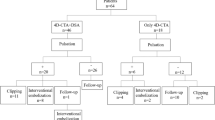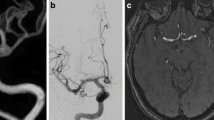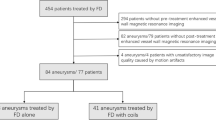Abstract
Purpose
Unruptured intracranial aneurysms (UIAs) at the distal internal carotid artery (ICA) (segments C5–C7) are difficult to accurately display on computed tomography angiography (CTA) due to the influences of bone structures and vessel curvature. We investigated the utility of three-dimensional time-of-flight magnetic resonance angiography (3D-TOF-MRA) at 3.0‑T for the detection of morphologic features compared to digital subtraction angiography (DSA).
Methods
This retrospective study included 2398 patients between January 2015 and May 2020 who underwent 3D-TOF-MRA and DSA within 3 months. Morphologic features including aneurysm size, neck width, shape and relation to adjacent arteries and other diagnostic parameters were recorded. Three observers blinded to the clinical and DSA results independently analyzed MRA data sets. The statistical difference of each aneurysm-specific variable was performed using χ2-tests and multivariate logistic regression analysis.
Results
A total of 551 aneurysms in 514 patients were confirmed at the distal ICA by DSA. Patient-based, aneurysm-based and location-based evaluations with 3D-TOF-MRA yielded high diagnostic accuracy in the detection of target UIAs. The accuracy of displayed morphologic features was 94.9% for size, 97.2% for neck width, 92.6% for shape, and 96.4% for relationship to adjacent vessels. Multivariate logistic regression showed that tiny (P < 0.001) or giant (P = 0.039) size and a lobulated shape (P = 0.006) significantly affected the morphologic assessment on 3D-TOF-MRA.
Conclusion
Three-dimensional TOF-MRA can accurately depict and display morphologic features of distal ICA UIAs. Tiny or giant-sized distal ICA aneurysms and with lobulation tend to carry a great risk of misdiagnosis in morphologic assessments.





Similar content being viewed by others
Abbreviations
- 3D-TOF-MRA:
-
Three-dimensional time-of-flight magnetic resonance angiography
- C5:
-
Clinoid segment
- C6:
-
Ophthalmic segment
- C7:
-
Communicating segment
- CI:
-
Confidence interval
- CVD:
-
Cardiovascular disease
- ICA:
-
Internal carotid artery
- MIP:
-
Maximum intensity projection
- OR:
-
Odds ratio
- UIAs:
-
Unruptured intracranial aneurysms
- VR:
-
Volume-rendering
References
Etminan N, Rinkel GJ. Unruptured intracranial aneurysms: development, rupture and preventive management. Nat Rev Neurol. 2016;12:699–713.
Imaizumi Y, Mizutani T, Shimizu K, Sato Y, Taguchi J. Detection rates and sites of unruptured intracranial aneurysms according to sex and age: an analysis of MR angiography-based brain examinations of 4070 healthy Japanese adults. J Neurosurg. 2018;130:573–8.
Menke J, Larsen J, Kallenberg K. Diagnosing cerebral aneurysms by computed tomographic angiography: meta-analysis. Ann Neurol. 2011;69:646–54.
Sailer AM, Wagemans BA, Nelemans PJ, de Graaf R, van Zwam WH. Diagnosing intracranial aneurysms with MR angiography: systematic review and meta-analysis. Stroke. 2014;45:119–26.
Chen W, Xing W, He Z, Peng Y, Wang C, Wang Q. Accuracy of 320-detector row nonsubtracted and subtracted volume CT angiography in evaluating small cerebral aneurysms. J Neurosurg. 2017;127:725–31.
Romijn M, Gratama van Andel HA, van Walderveen MA, Sprengers ME, van Rijn JC, van Rooij WJ, Venema HW, Grimbergen CA, den Heeten GJ, Majoie CB. Diagnostic accuracy of CT angiography with matched mask bone elimination for detection of intracranial aneurysms: comparison with digital subtraction angiography and 3D rotational angiography. AJNR Am J Neuroradiol. 2008;29:134–9.
Liao CH, Lin CJ, Lin CF, Huang HY, Chen MH, Hsu SP, Shih YH. Comparison of the effectiveness of using the optic strut and tuberculum sellae as radiological landmarks in diagnosing paraclinoid aneurysms with CT angiography. J Neurosurg. 2016;125:275–82.
Lindgren AE, Koivisto T, Björkman J, von Und Zu Fraunberg M, Helin K, Jääskeläinen JE, Frösen J. Irregular Shape of Intracranial Aneurysm Indicates Rupture Risk Irrespective of Size in a Population-Based Cohort. Stroke. 2016;47:1219–26.
Nakagawa D, Nagahama Y, Policeni BA, Raghavan ML, Dillard SI, Schumacher AL, Sarathy S, Dlouhy BJ, Wilson S, Allan L, Woo HH, Huston J, Cloft HJ, Wintermark M, Torner JC, Brown RD, Hasan DM. Accuracy of detecting enlargement of aneurysms using different MRI modalities and measurement protocols. J Neurosurg. 2018;130:559–65.
Malhotra A, Wu X, Forman HP, Matouk CC, Gandhi D, Sanelli P. Management of tiny unruptured intracranial aneurysms: a comparative effectiveness analysis. JAMA Neurol. 2018;75:27–34.
Li M, Zhu Y, Song H, Gu B, Lu H, Li Y, Tan H, Cheng Y. Subarachnoid Hemorrhage in Patients with Good Clinical Grade: Accuracy of 3.0-T MR Angiography for Detection and Characterization. Radiology. 2017;284:191–9.
Bouthillier A, van Loveren HR, Keller JT. Segments of the internal carotid artery: a new classification. Neurosurgery. 1996;38:425–32. discussion 432–423.
van Rooij WJ, Sluzewski M. Endovascular treatment of large and giant aneurysms. AJNR Am J Neuroradiol. 2009;30:12–8.
Chappell ET, Moure FC, Good MC. Comparison of computed tomographic angiography with digital subtraction angiography in the diagnosis of cerebral aneurysms: a meta-analysis. Neurosurgery. 2003;52:624–31. discussion 630–621.
Wang X, Benson J, Jagadeesan B, McKinney A. Giant cerebral aneurysms: comparing CTA, MRA, and digital subtraction angiography assessments. J Neuroimaging. 2020;30:335–41.
Philipp LR, McCracken DJ, McCracken CE, Halani SH, Lovasik BP, Salehani AA, Boulter JH, Cawley CM, Grossberg JA, Barrow DL, Pradilla G. Comparison Between CTA and Digital Subtraction Angiography in the Diagnosis of Ruptured Aneurysms. Neurosurgery. 2017;80:769–77.
van Asch CJ, Velthuis BK, Rinkel GJ, Algra A, de Kort GA, Witkamp TD, de Ridder JC, van Nieuwenhuizen KM, de Leeuw FE, Schonewille WJ, de Kort PL, Dippel DW, Raaymakers TW, Hofmeijer J, Wermer MJ, Kerkhoff H, Jellema K, Bronner IM, Remmers MJ, Bienfait HP, Witjes RJ, Greving JP, Klijn CJ; DIAGRAM Investigators. Diagnostic yield and accuracy of CT angiography, MR angiography, and digital subtraction angiography for detection of macrovascular causes of intracerebral haemorrhage: prospective, multicentre cohort study. BMJ. 2015;351:h5762.
Yang ZL, Ni QQ, Schoepf UJ, De Cecco CN, Lin H, Duguay TM, Zhou CS, Zhao YE, Lu GM, Zhang LJ. Small Intracranial Aneurysms: Diagnostic Accuracy of CT Angiography. Radiology. 2017;285:941–52.
Hiratsuka Y, Miki H, Kiriyama I, Kikuchi K, Takahashi S, Matsubara I, Sadamoto K, Mochizuki T. Diagnosis of unruptured intracranial aneurysms: 3T MR angiography versus 64-channel multi-detector row CT angiography. Magn Reson Med Sci. 2008;7:169–78.
Ramachandran M, Retarekar R, Harbaugh RE, Hasan D, Policeni B, Rosenwasser R, Ogilvy C, Raghavan ML. Sensitivity of Quantified Intracranial Aneurysm Geometry to Imaging Modality. Cardiovasc Eng Technol. 2013;4:75–86.
Mocco J, Brown RD Jr, Torner JC, Capuano AW, Fargen KM, Raghavan ML, Piepgras DG, Meissner I, Huston J III; International Study of Unruptured Intracranial Aneurysms Investigators. Aneurysm Morphology and Prediction of Rupture: An International Study of Unruptured Intracranial Aneurysms Analysis. Neurosurgery. 2018;82:491–6.
Li MH, Cheng YS, Li YD, Fang C, Chen SW, Wang W, Hu DJ, Xu HW. Large-cohort comparison between three-dimensional time-of-flight magnetic resonance and rotational digital subtraction angiographies in intracranial aneurysm detection. Stroke. 2009;40:3127–9.
Zhu C, Wang X, Eisenmenger L, Tian B, Liu Q, Degnan AJ, Hess C, Saloner D, Lu J. Surveillance of Unruptured Intracranial Saccular Aneurysms Using Noncontrast 3D-Black-Blood MRI: Comparison of 3D-TOF and Contrast-Enhanced MRA with 3D-DSA. AJNR Am J Neuroradiol. 2019;40:960–6.
Chen CJ, Moosa S, Ding D, Raper DM, Burke RM, Lee CC, Chivukula S, Wang TR, Starke RM, Crowley RW, Liu KC. Infundibular dilations of the posterior communicating arteries: pathogenesis, anatomical variants, aneurysm formation, and subarachnoid hemorrhage. J Neurointerv Surg. 2016;8:791–5.
Kinouchi H, Mizoi K, Nagamine Y, Yanagida N, Mikawa S, Suzuki A, Sasajima T, Yoshimoto T. Anterior paraclinoid aneurysms. J Neurosurg. 2002;96:1000—5.
Björkman J, Frösen J, Tähtinen O, Backes D, Huttunen T, Harju J, Huttunen J, Kurki MI, von Und Zu Fraunberg M, Koivisto T, Manninen H, Jääskeläinen JE, Lindgren AE. Irregular Shape Identifies Ruptured Intracranial Aneurysm in Subarachnoid Hemorrhage Patients With Multiple Aneurysms. Stroke. 2017;48:1986–9.
Funding
This study received funding by 1) National Key Research and Development Program (No. 2017YFC0109204); 2) Shanghai Municipal Education Commission-Gaofeng Clinical Medicine Grant Support (No.20152528); 3) Shanghai Jiao Tong University “Medical and Research” Program (ZH2018ZDA19).
Author information
Authors and Affiliations
Corresponding author
Ethics declarations
Conflict of interest
G. He, J. Wang, Y. Zhang, M. Li, H. Lu, Y. Cheng and Y. Zhu declare that they have no competing interests.
Ethical standards
For this article no studies with human participants or animals were performed by any of the authors. All studies performed were in accordance with the ethical standards indicated in each case. Institutional Review Board approval was obtained. Informed consent: written informed consent was waived.
Supplementary Information
Rights and permissions
About this article
Cite this article
He, G., Wang, J., Zhang, Y. et al. Diagnostic Performance of MRA for UnrupturedAneurysms at the Distal ICA. Clin Neuroradiol 32, 507–515 (2022). https://doi.org/10.1007/s00062-021-01076-4
Received:
Accepted:
Published:
Issue Date:
DOI: https://doi.org/10.1007/s00062-021-01076-4




